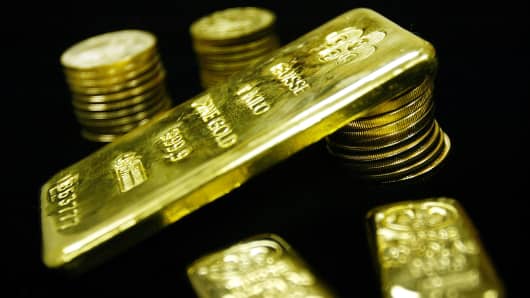Gold has been a standout performer against all other asset classes this year. But despite economic and financial market uncertainties, we do not believe it is a one-way bet. The high gold price is unsustainable, in our view, unless the U.S. enters a recession or the U.S.Federal Reserve completely reverses course on monetary policy.
Investors should consider reducing their gold holdings if the price approaches $1,310 an ounce over the coming weeks and increasing them if prices fall back to $ 1,100 an ounce.
Gold has outperformed all other asset classes this year, rising 19 percent as falling bond yields and negative interest rates pique investors' interest. Because rates are now negative in many developed nations, the opportunity cost of holding gold has fallen relative to assets that pay an income, such as bonds. This raises its appeal as an insurance against further financial market turmoil.
Without a further deterioration in risk sentiment, however, we believe it's now too late to join the rally. We expect the price trend to reverse if U.S. economic data improves. Stronger U.S. data should allow the Federal Reserve to normalize monetary policy further and earlier than currently predicted by federal funds futures.
While gold price should come under pressure again, we reiterate our view that the structural decline in gold prices is over. Negative real U.S. rates, newfound investment demand, and central bank purchases are supportive of gold at around $ 1,200 an ounce over six to 12 months, in our view. Falling mine supply is another supportive element, although higher gold prices should increase scrap supplies and might raise the prospect of availability over and above our expectations.
Nevertheless, unless you expect a U.S. recession and the Fed to reverse course completely or engage in another round of quantitative easing, gold's current price rally is likely near its peak. Non-investment gold demand is likely to weaken at these price levels, and we expect import statistics and regional price spreads to confirm this in the coming weeks.
This leaves speculators and funds as the only buyers in town, in our opinion. Anecdotal information points us toward renewed interest from fund managers in gold as insurance for portfolios, not merely as a safe haven. We see these allocations as difficult to unseat in the coming year, even as appetite for risk returns. However, as speculative positions shift closer toward extreme levels, the risks of a swift reversal in these positions grow, as does the potential for setbacks in the price.
Taking large positions in gold as an insurance against a broad-based global financial crisis is an overly dramatic step, in our view. Investors who have opportunistically held gold into the beginning of the year have an opportunity to exit these positions with a significant gain. In anybody's terms, gold now looks richly priced against all other assets and commodities in particular.
Opportunistic long positions in gold only make sense to us once prices have reversed. With an equilibrium price for gold at around $1,200 an ounce over the next year, investors should consider $1,100 an ounce as an entry point if they wish to improve their chances of an attractive future payoff.
The message is similar for investors with a very long-term investment horizon, who are often holders of gold for intergenerational purposes or because of their affinity for real assets. After such a sharp rise in gold values, by implication, total gold holdings within any portfolio have increased on a relative basis. We are therefore at an opportune time to consider a rebalancing of those holdings in the context of maintaining a diversified portfolio.
Commentary by Wayne Gordon, a commodity and currency strategist in the chief investment office at UBS Wealth Management, which oversees the investment strategy for $2 trillion in assets. Follow UBS on Twitter @UBS.
For more insight from CNBC contributors, follow
@CNBCopinion
on Twitter.





